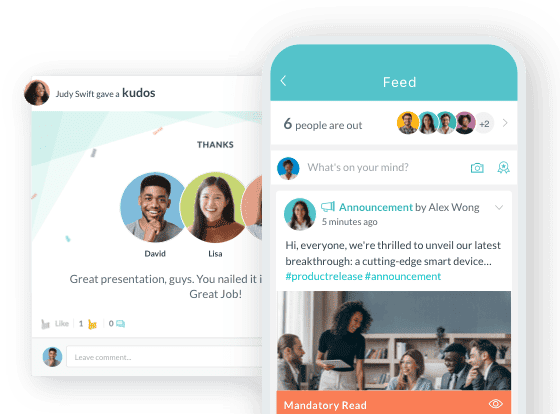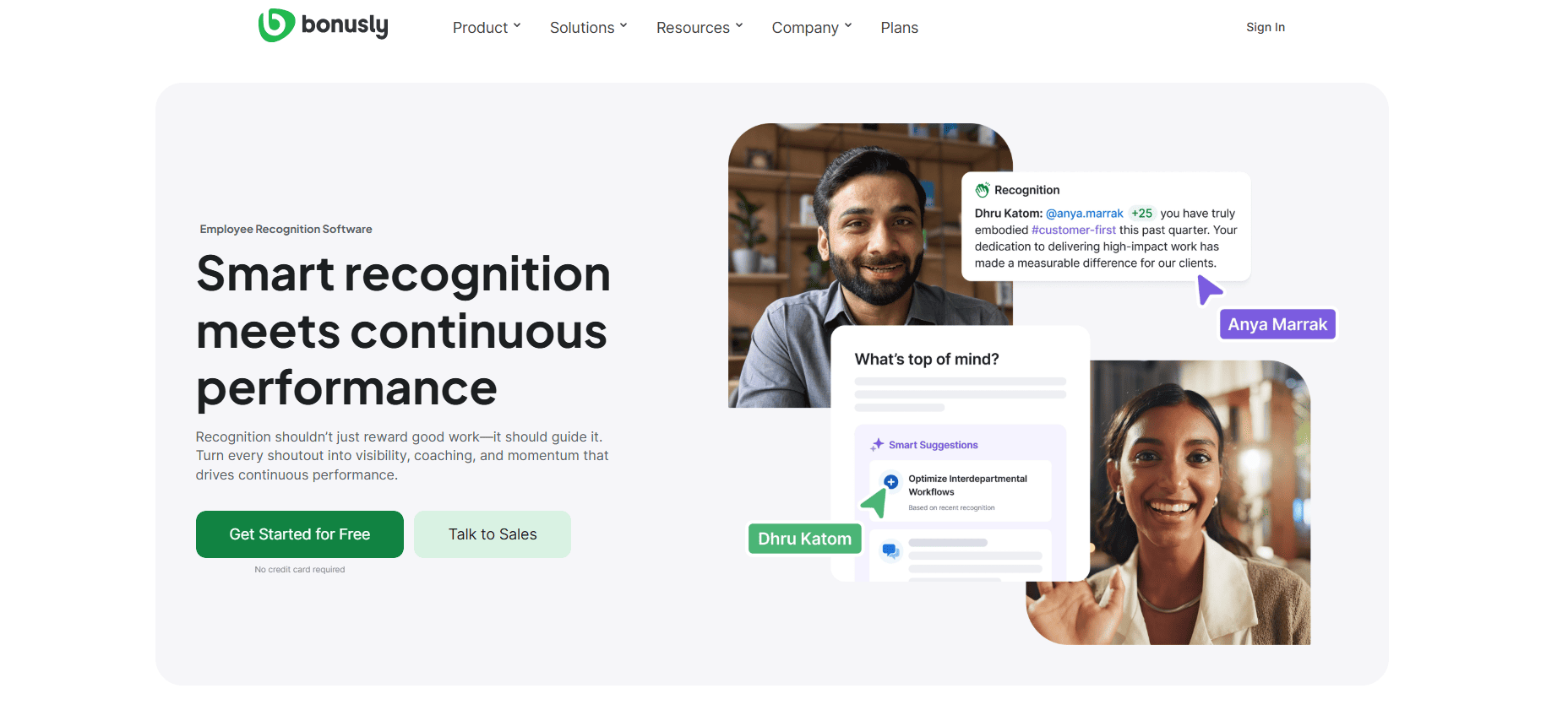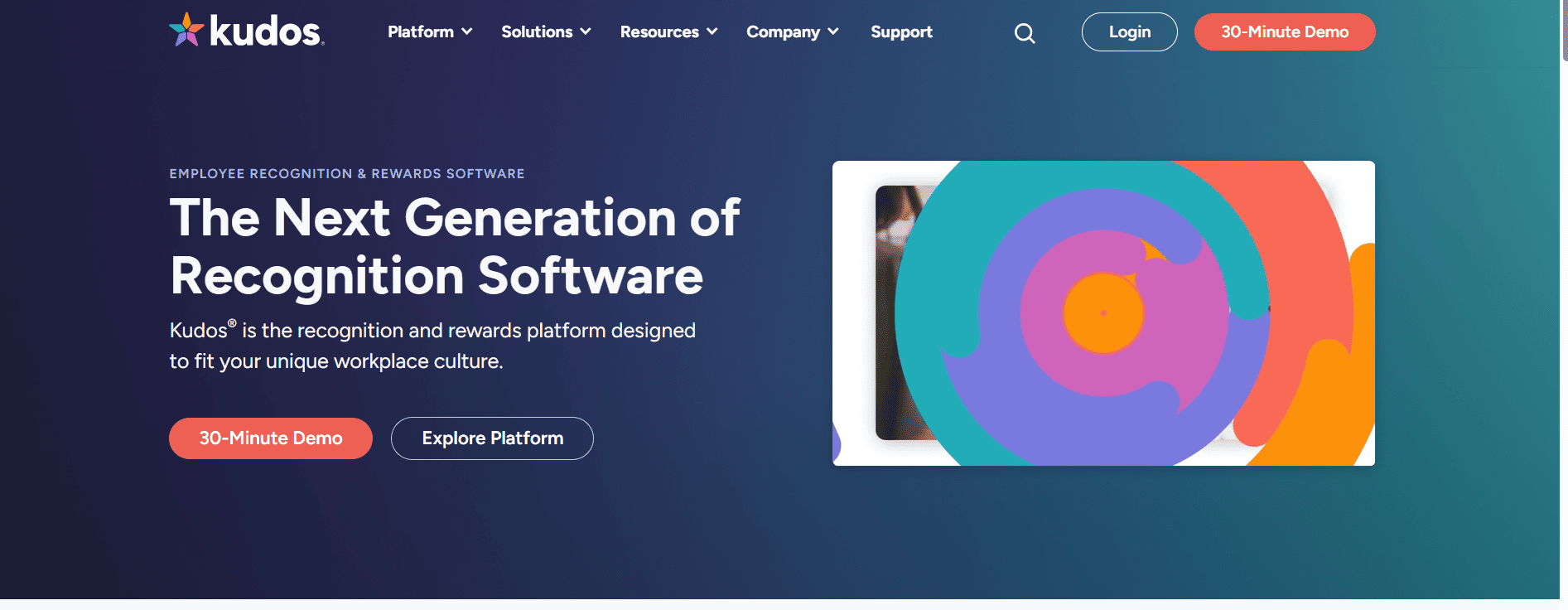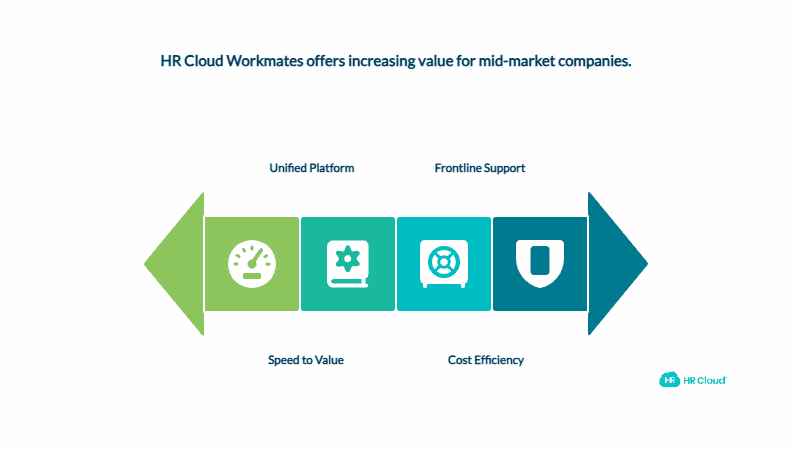Bonusly vs Kudos vs HR Cloud: The Ultimate Employee Recognition Platform Comparison for Mid-Market Companies in 2025
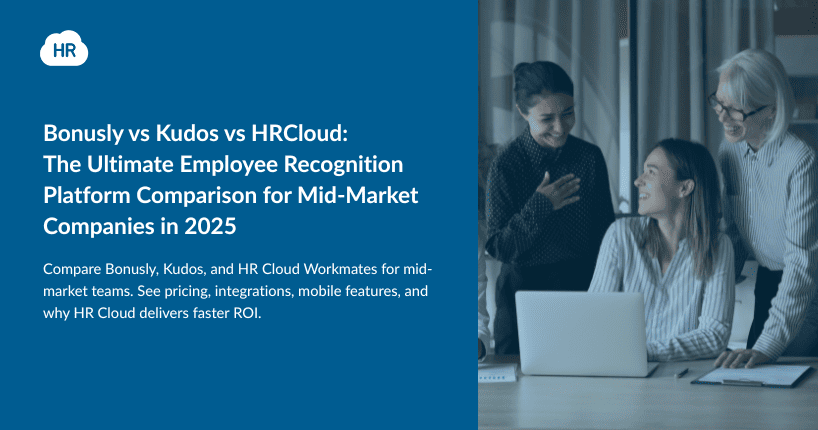
- Why Employee Recognition Platforms Matter for Mid-Market Companies
- Platform Overview: Bonusly Employee Recognition Software
- Platform Overview: Kudos Enterprise Recognition Platform
- Platform Overview: HRCloud Workmates Unified Employee Experience Platform
- Head-to-Head Comparison Table
- Mid-Market Buyer's Checklist
- Why HRCloud Workmates Stands Out for Mid-Market Companies
- Implementation and ROI Considerations
- Final Recommendation and Next Steps
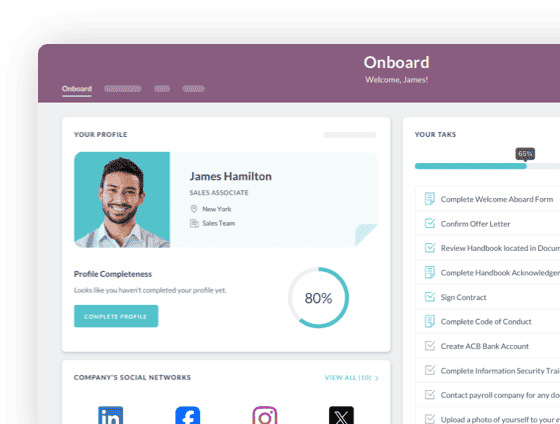
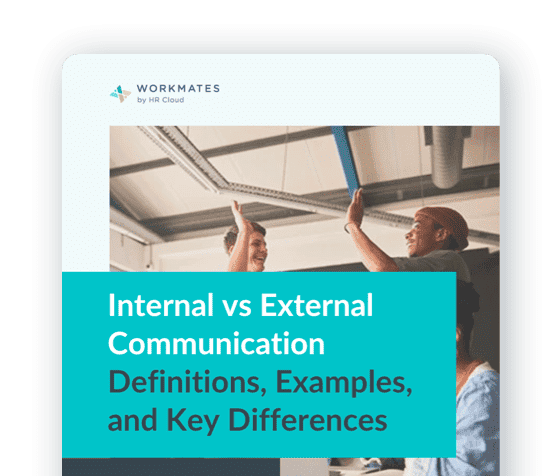
 Cut onboarding time
by 60%—here's the
Ultimate Checklist
that helped do it.
Cut onboarding time
by 60%—here's the
Ultimate Checklist
that helped do it.
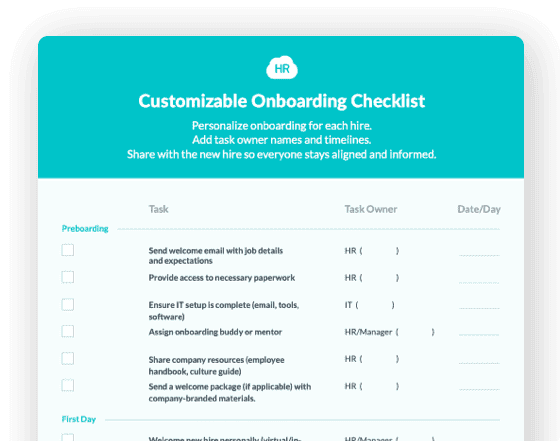
While Bonusly excels at simple peer-to-peer recognition and Kudos offers enterprise-grade analytics, HR Cloud's Workmates emerges as the strategic choice for mid-market companies (100-1,000 employees). Its unified platform approach combines recognition with HRIS, communication, and engagement tools, delivering faster implementation, better cost efficiency, and comprehensive support for distributed teams—all without the complexity overload that typically comes with enterprise solutions.
Key Takeaways
-
Recognition drives measurable business results: Companies with strong recognition programs see 31% lower voluntary turnover and 87% of employees report that meaningful recognition impacts job satisfaction
-
Mid-market companies need specialized solutions: Unlike startups or enterprises, mid-market organizations require platforms that balance functionality with simplicity while supporting distributed workforces
-
Platform integration matters more than features: Comprehensive platforms like HR Cloud Workmates see 3-5x higher adoption rates than standalone recognition tools because friction disappears
-
Mobile-first design is non-negotiable: For companies with frontline or deskless workers, mobile accessibility can increase response rates by 40-60%
-
HR Cloud Workmates offers the best mid-market value: With 2-4 week implementation, unified HR platform benefits, and proven 4.6/5 Capterra rating, it addresses mid-market pain points better than point solutions
The employee recognition software landscape has never been more competitive—or more confusing. With the market projected to reach significant growth driven by digital engagement tools, mid-market companies find themselves caught between solutions that are either too simple or overwhelmingly complex.
Sarah, an HR director at a 350-employee logistics company, recently told us her recognition platform challenge: "We tried a simple peer-to-peer tool, but it felt disconnected from everything else we do. Then we looked at enterprise platforms that would take six months to implement and cost more than our entire HR budget."
Sound familiar? Mid-market companies—those with 100 to 1,000 employees—face unique challenges in employee engagement and workforce management. They've outgrown simple solutions but can't justify enterprise complexity. They need recognition platforms that integrate seamlessly with existing systems, deploy quickly, and work for both office workers and frontline teams.
This comprehensive comparison examines three leading platforms: Bonusly's peer-to-peer simplicity, Kudos' enterprise-grade analytics, and HR Cloud's unified approach. But we'll cut through the marketing noise to focus on what actually matters for mid-market success: implementation speed, adoption rates, cost efficiency, and real-world usability for employee recognition software buyers.
The best employee recognition platform for mid-market companies must deliver measurable ROI while addressing specific challenges like workforce management, employee engagement software integration, and distributed team coordination. Whether you're evaluating recognition and rewards platforms, employee appreciation software, or comprehensive HR technology solutions, this analysis provides the data-driven insights needed for informed purchasing decisions.
Ready to transform your recognition strategy? Schedule a demo to see how HR Cloud Workmates creates meaningful appreciation experiences that drive business results.
Why Employee Recognition Platforms Matter for Mid-Market Companies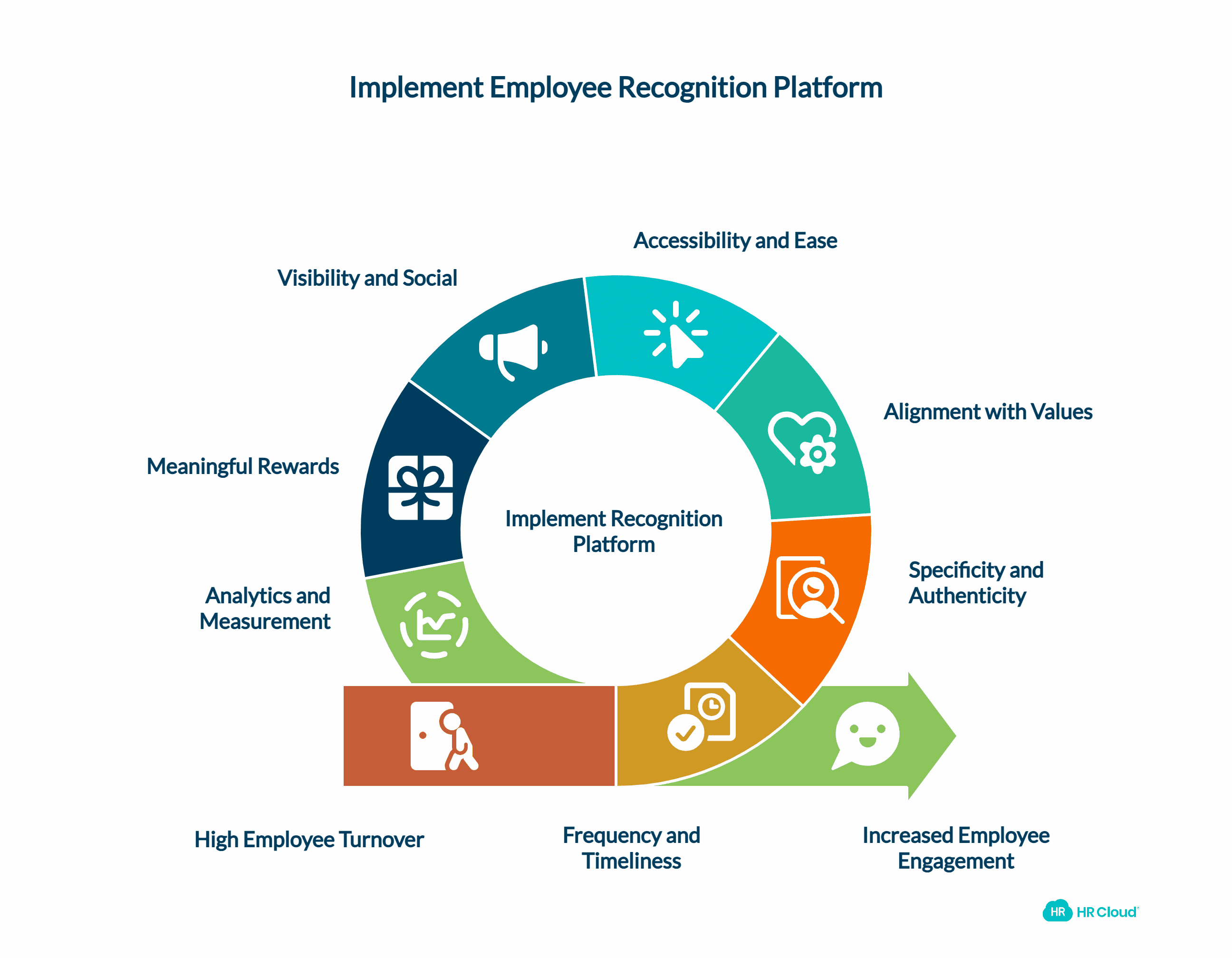
Mid-market organizations occupy a fascinating sweet spot in the business world. With 100-1,000 employees, they're large enough to need structured processes but agile enough to implement them quickly. However, this positioning creates specific challenges that employee recognition software must address for effective workforce management.
Research shows that 87% reduction in turnover rates occurs when organizations invest in comprehensive engagement programs, making recognition a strategic necessity rather than a nice-to-have for business growth. For mid-market companies where every employee departure impacts operations significantly, this statistic transforms recognition from an HR initiative to a business imperative.
The business case extends beyond retention. Harvard Business Review research confirms that companies with effective recognition programs report 23% higher profitability compared to competitors, while employees who receive meaningful weekly recognition are 9x more likely to feel a strong sense of belonging.
But here's where mid-market companies differ from their smaller and larger counterparts: they need platforms that scale efficiently without overwhelming complexity. A startup with 25 employees can manage recognition through Slack messages. An enterprise with 10,000 employees can afford six-month implementations and dedicated program managers. Mid-market companies need something in between—sophisticated enough to drive results, simple enough to deploy quickly.
According to Gallup's latest research, managers account for 70% of the variance in team engagement, making the right recognition platform selection critical for mid-market growth.
Transform your employee recognition strategy with a platform built for mid-market success. Schedule a personalized demo to see how HR Cloud Workmates delivers enterprise-grade results without enterprise complexity.
What Makes an Effective Employee Recognition Program
An effective employee recognition program combines several key elements that drive engagement and business results:
Frequency and Timeliness: Recognition should happen immediately after positive behaviors or achievements, not weeks later during formal review cycles.
Specificity and Authenticity: Generic "good job" messages lack impact. Effective recognition explains exactly what the employee did well and why it matters to the organization.
Alignment with Company Values: Recognition programs work best when they reinforce specific organizational values and desired behaviors.
Accessibility and Ease of Use: If the recognition process is complicated or time-consuming, adoption rates plummet across the organization.
Visibility and Social Recognition: Public recognition amplifies impact and encourages others to exhibit similar positive behaviors.
Meaningful Rewards: Whether monetary or non-monetary, rewards should be valuable to recipients and aligned with their preferences.
Analytics and Measurement: Successful programs track participation rates, engagement metrics, and business outcomes to demonstrate ROI.
Key Selection Criteria for Mid-Market Recognition Software
For mid-market organizations selecting employee recognition software, these criteria determine platform success:
-
Implementation Speed: 2-6 weeks maximum deployment time, not months of complex setup procedures
-
Cost Predictability: Transparent per-seat pricing that scales reasonably with organizational growth and budget planning
-
Integration Depth: Native connections with existing HRIS systems, Slack, Microsoft Teams, and mobile applications for seamless workflow integration
-
Frontline Readiness: Mobile-first design optimized for deskless workers, field employees, and distributed workforce management
-
Analytics Without Complexity: Actionable insights and reporting capabilities without requiring dedicated data science resources
-
Vendor Support Quality: Responsive customer success teams that understand mid-market constraints and implementation timelines
-
Scalability Planning: Platform architecture that grows from hundreds to thousands of employees without performance degradation
-
Security and Compliance: Enterprise-grade security features, including SSO, data encryption, and industry compliance standards
Platform Overview: Bonusly Employee Recognition Software
Bonusly has carved out a distinctive position in the recognition software market by focusing relentlessly on peer-to-peer appreciation and social recognition. The platform operates on a simple premise: give every employee a monthly allowance of points to recognize colleagues, creating a continuous flow of appreciation throughout the organization.
Bonusly Features and Capabilities
The platform's strength lies in its simplicity and ease of use for employee appreciation programs. Bonusly reports that 82% of users actively engage with the platform twice each week, an impressive adoption rate that stems from its intuitive design and user-friendly interface. The recognition process takes seconds—select a colleague, choose points to give, add a personalized message, and optionally include hashtags or GIFs for social engagement.
Bonusly's integration ecosystem stands out among peer-to-peer recognition platforms. Native Slack and Microsoft Teams connections mean recognition happens within tools employees already use daily, reducing friction and increasing participation rates. The public recognition feed creates visibility around appreciation, encouraging others to participate and building momentum for positive workplace culture.
The rewards marketplace offers flexibility with gift cards, charitable donations, and company-branded merchandise options. Employees can redeem accumulated points for rewards that matter to them personally, creating meaningful incentives for continued engagement.
Pricing starts at $2 per user monthly for basic appreciation features, scaling to $7 per user per month for advanced capabilities including detailed analytics and custom integrations, making it accessible for mid-market budgets and workforce management planning.
Mid-Market Considerations for Bonusly Implementation
However, several factors limit Bonusly's effectiveness for growing mid-market companies evaluating employee recognition software solutions. The platform's simplicity becomes a constraint when organizations need deeper analytics, workforce insights, or integration with comprehensive performance management systems. While Bonusly focuses on peer recognition, it provides limited comprehensive software with analytics and engagement tracking suitable for larger enterprises requiring detailed reporting and ROI measurement.
Cost scaling presents another challenge for budget-conscious mid-market organizations. At $7 per user monthly for full features, a 500-employee company faces $42,000 annually just for recognition software—before factoring in reward fulfillment costs and administrative overhead. For mid-market companies managing multiple HR priorities and software vendor relationships, this investment needs to deliver proportional value across the entire employee experience.
Recent Gallup research partnered with Workhuman found that an organization of 10,000 people can save more than $16M annually in employee turnover costs when they make recognition an important part of their culture.
Perhaps most significantly for mid-market growth and digital transformation, Bonusly operates as a standalone tool. While this simplicity appeals to smaller organizations, mid-market companies increasingly need platforms that connect recognition to broader employee experience initiatives like onboarding automation, performance management workflows, and internal communication systems for comprehensive workforce management.
Discover how integrated recognition creates 5x higher adoption rates in our remote employee recognition playbook.
Bonusly Quick Reference
|
Feature |
Details |
|
Starting Price |
$2/user/month (Appreciate plan) |
|
Advanced Price |
$7/user/month (Achieve plan) |
|
Implementation |
4-6 weeks |
|
Best For |
Small to mid-sized teams (25-300 employees) |
|
Core Strength |
Peer-to-peer simplicity |
|
Integration Highlights |
Slack, Microsoft Teams, basic HRIS |
|
Mobile App |
Available iOS/Android |
|
Customer Support |
Standard business hours |
|
User Engagement |
82% active twice weekly |
Platform Overview: Kudos Enterprise Recognition Platform
Kudos positions itself as an enterprise-grade employee recognition and engagement platform that goes beyond simple peer-to-peer appreciation. The platform emphasizes values-driven recognition, comprehensive workforce analytics, and cultural measurement capabilities—appealing to organizations that want sophisticated insights into their recognition programs and employee engagement initiatives.
Kudos Platform Capabilities and Features
Users report that Kudos excels in peer recognition features with a score of 9.7, while offering superior employee engagement tools scoring 9.3 according to verified user reviews. The platform's "Kudos Board" creates visual, engaging recognition experiences that highlight achievements prominently and reinforce organizational values through structured appreciation workflows.
Kudos differentiates itself through deep analytics capabilities and business intelligence features. The platform tracks recognition patterns, measures cultural alignment, and provides insights that help leaders understand engagement trends across departments, teams, and geographic locations. For organizations that want to treat recognition as a strategic business initiative with measurable outcomes and ROI tracking, Kudos offers sophistication that simpler platforms lack.
The platform supports global organizations with multi-language capabilities, international reward fulfillment, and compliance features across numerous countries. Kudos operates in over 80 countries across six continents, making it suitable for mid-market companies with international operations, remote workforce management, and distributed team coordination requirements.
Enterprise Focus and Implementation Complexity
Despite its comprehensive capabilities, Kudos presents several barriers for mid-market adoption and software purchasing decisions. The platform typically uses quote-based pricing rather than transparent per-seat costs, creating budget uncertainty that mid-market finance teams often find problematic when evaluating employee recognition software vendors. Implementation complexity can extend timelines beyond what agile mid-market organizations prefer for workforce management solutions.
User feedback indicates navigation challenges and user experience issues, with employees finding it difficult to do basic tasks like edit posts, search for recognition history, or navigate the rewards catalog efficiently. For mid-market companies where HR teams wear multiple hats and handle diverse responsibilities, platforms that require extensive training and ongoing management create operational strain and resource allocation challenges.
Kudos' enterprise focus means features often exceed mid-market needs while creating complexity that doesn't add value to smaller organizations. Organizations with 200-500 employees may find themselves paying for advanced analytics capabilities, global compliance features, and enterprise integrations they'll never use while struggling with interfaces designed for much larger teams and more complex organizational structures.
As Harvard Business Review notes, there's an important distinction between recognition and appreciation—successful programs need both, but complexity can undermine authentic culture building and employee engagement efforts.
Discover how to balance sophistication with simplicity. See how HRCloud Workmates delivers enterprise capabilities through an intuitive, mid-market friendly interface.
See how mid-market companies are bridging the gap between simple tools and enterprise complexity in our guide to employee engagement platforms.
Kudos Quick Reference
|
Feature |
Details |
|
Pricing Model |
Quote-based (enterprise focus) |
|
Implementation |
8-12 weeks typical |
|
Best For |
Large enterprises (500+ employees) |
|
Core Strength |
Values-driven analytics |
|
Global Reach |
80+ countries, 6 continents |
|
Analytics Depth |
Advanced cultural measurement |
|
Customer Support |
24/7 phone, chat, email |
|
G2 Score |
9.7/10 for peer recognition features |
|
User Feedback |
Complex navigation, enterprise-focused |
Platform Overview: HR Cloud Workmates Unified Employee Experience Platform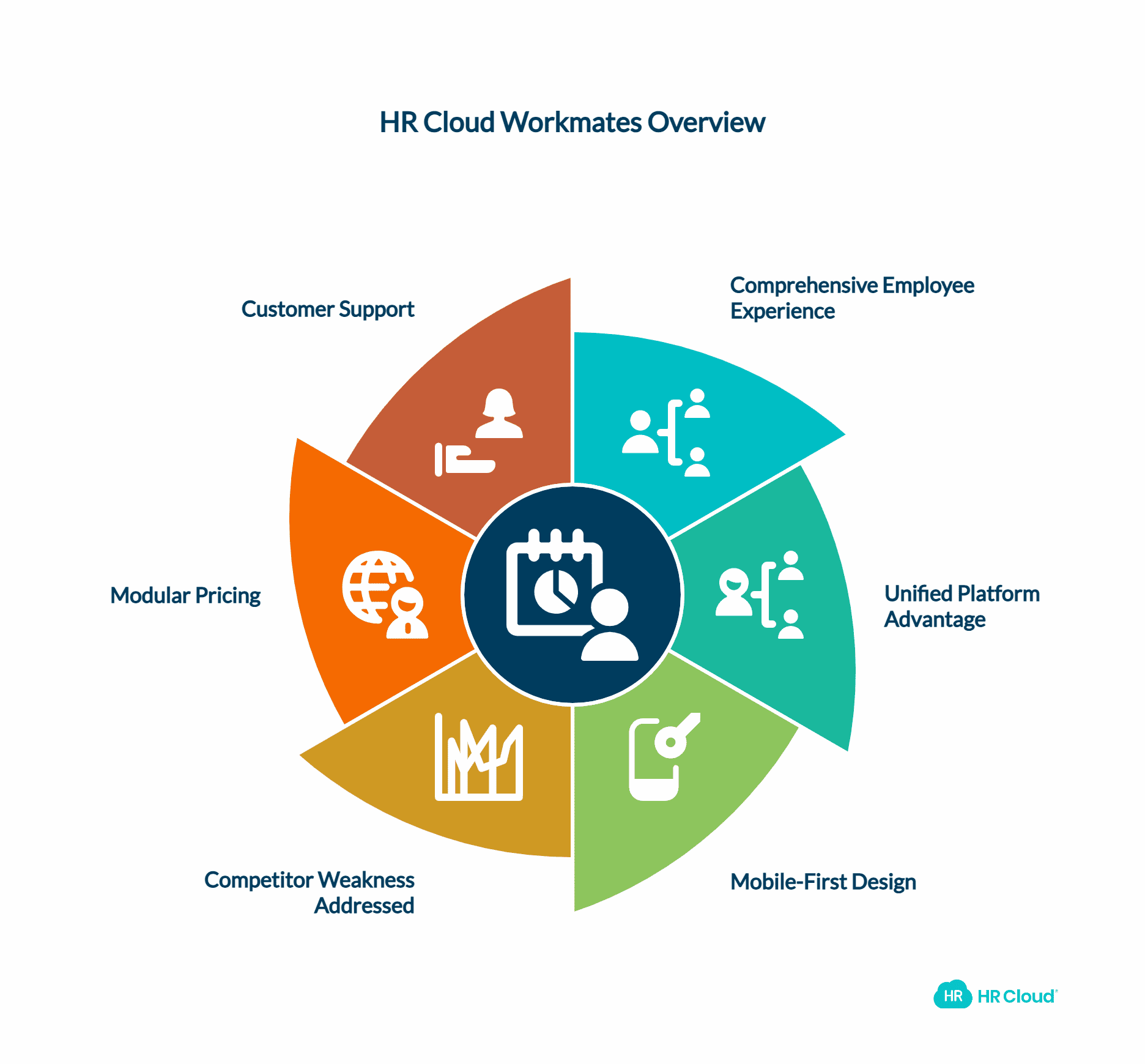
HR Cloud takes a fundamentally different approach to employee recognition by treating it as one component of a comprehensive employee experience and workforce management platform. Rather than competing on recognition features alone, Workmates integrates appreciation with communication, onboarding, and engagement tools—creating what many mid-market companies describe as their "employee engagement hub" and digital workplace solution.
The Unified Platform Advantage for Workforce Management
HR Cloud Workmates earns strong marks for comprehensive employee experience with a 4.6/5 rating on Capterra based on verified customer reviews. Users consistently praise its ease of use, quick adoption rates, and the all-in-one approach that eliminates fragmented tool landscapes common in mid-market organizations managing multiple software vendors.
What sets Workmates apart from standalone recognition software is integration depth and data connectivity. The platform integrates with leading HRIS platforms, including ADP, UKG, Workday, Paycor, and Paylocity, ensuring seamless data synchronization across your entire HR technology stack. ADP integration is particularly robust, with pre-built connectors for RUN, TotalSource, Workforce Now, Vantage, and Next Gen. This means recognition data automatically connects to employee profiles, performance metrics, and organizational charts—eliminating manual data entry and ensuring programs stay current with real-time workforce information. Leading employee recognition software platforms like Workmates follow
Mobile-First Design for Distributed Workforce Management
The platform excels in several critical areas where competitors struggle, particularly for organizations with frontline workers, retail locations, manufacturing facilities, or distributed teams. Native Slack and Teams integration means recognition happens in workflow rather than requiring separate application access, significantly improving adoption rates among busy employees.
For mid-market companies with frontline workers, retail locations, or distributed teams, this mobile-first approach proves essential for comprehensive workforce engagement. Healthcare organizations particularly appreciate features designed for shift-based work environments, while manufacturing and retail companies benefit from deskless worker optimization and field employee accessibility.
Customer reviews indicate rapid implementation, typically completing within 2-4 weeks compared to longer timelines often required by enterprise platforms, addressing the speed-to-value requirements critical for mid-market organizations. The platform supports over 100 gift card options with global accessibility, automated milestone recognition, and real-time analytics dashboards that identify engagement gaps and recognition equity issues across different employee segments.
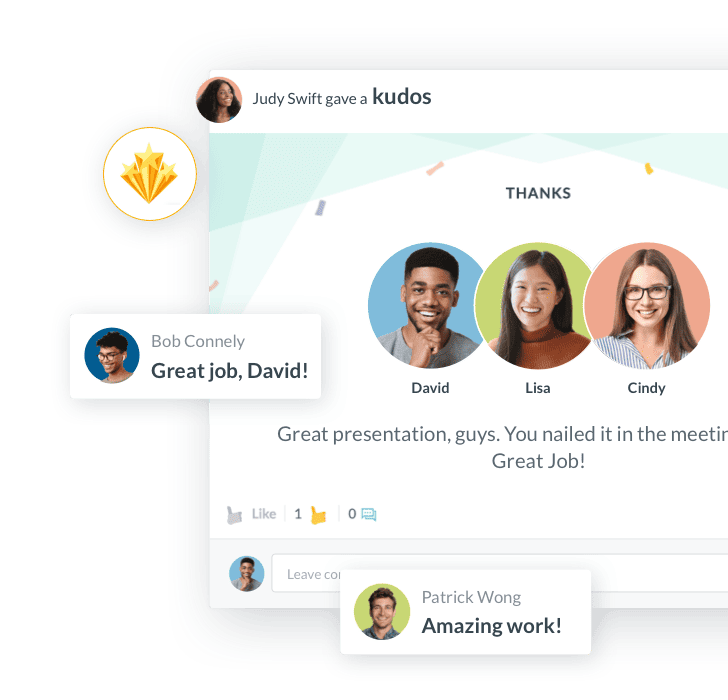
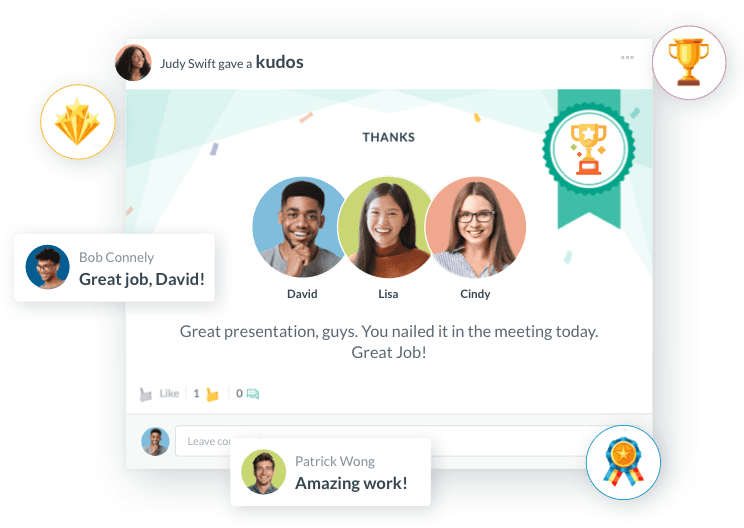
How Workmates Addresses Competitor Weaknesses in Employee Recognition Software
Where Bonusly offers simplicity but lacks analytics depth and comprehensive reporting capabilities, Workmates provides detailed engagement metrics, recognition analytics, and workforce insights without overwhelming complexity or requiring dedicated data science resources. The platform delivers actionable business intelligence that mid-market leaders can use immediately for decision-making and program optimization.
Where Kudos delivers enterprise features but creates adoption barriers and implementation challenges, Workmates offers sophisticated capabilities through intuitive interfaces designed specifically for mid-market usability. The platform combines advanced functionality with a user-friendly design, ensuring high adoption rates across diverse employee populations, including frontline workers, remote teams, and office-based staff.
The modular pricing approach allows organizations to start with core recognition features and scale naturally through additional modules like communication, surveys, and performance management—addressing the cost unpredictability and budget constraints that concern mid-market finance teams evaluating employee recognition software vendors.
Customers highlight "A+ support" and responsive customer success teams in verified reviews, providing the partnership approach and dedicated account management that resource-constrained mid-market HR teams need for successful implementation and ongoing program optimization. This level of support contrasts with larger vendors that often provide limited attention to mid-market accounts.
Explore how comprehensive platforms address recognition challenges through integrated technology in our peer-to-peer recognition guide.
HR Cloud Workmates Quick Reference
|
Feature |
Details |
|
Pricing Model |
Modular, scalable per-seat |
|
Implementation |
2-4 weeks rapid deployment |
|
Best For |
Mid-market companies (100-1,000 employees) |
|
Core Strength |
Unified employee experience platform |
|
HRIS Integration |
ADP, UKG, Workday, Paycor, Paylocity |
|
Mobile Experience |
Mobile-first design for deskless workers |
|
Capterra Rating |
4.6/5 based on verified reviews |
|
Customer Support |
Responsive success teams, A+ rated |
|
Platform Approach |
All-in-one: recognition + communication + surveys |
Head-to-Head Comparison Table
|
Criteria |
Bonusly |
Kudos |
HR Cloud Workmates |
|
Implementation Time |
4-6 weeks |
8-12 weeks |
2-4 weeks |
|
Pricing Transparency |
Clear per-seat |
Quote-based |
Modular, scalable |
|
HRIS Integration |
Limited |
Moderate |
Native (ADP, UKG, Workday+) |
|
Mobile Experience |
Good |
Good |
Excellent (mobile-first) |
|
Analytics Depth |
Basic reporting |
Advanced analytics |
Actionable insights |
|
Frontline Support |
Limited |
Limited |
Purpose-built |
|
Customer Support |
Standard |
24/7 available |
Responsive success teams |
|
Platform Approach |
Standalone tool |
Standalone tool |
Unified experience |
|
Best For |
Small-mid teams |
Large enterprises |
Mid-market growth |
Ready to see these differences in action? Schedule a personalized demo to experience how Workmates transforms recognition into strategic advantage.
Pricing Comparison for Mid-Market Companies
|
Company Size |
Bonusly Annual Cost |
Kudos Annual Cost |
HR Cloud Workmates |
|
200 employees |
$16,800 - $33,600 |
Quote-based (typically higher) |
Modular pricing, competitive |
|
400 employees |
$33,600 - $67,200 |
Quote-based (enterprise rates) |
Scalable, cost-predictable |
|
750 employees |
$63,000 - $126,000 |
Quote-based (premium) |
Growth-friendly pricing |
Note: Costs include platform fees only. Reward fulfillment budgets are additional.
Feature Depth Comparison
|
Capability |
Bonusly |
Kudos |
HR Cloud Workmates |
|
Peer-to-Peer Recognition |
⭐⭐⭐⭐⭐ |
⭐⭐⭐⭐⭐ |
⭐⭐⭐⭐⭐ |
|
Manager Recognition Tools |
⭐⭐⭐ |
⭐⭐⭐⭐ |
⭐⭐⭐⭐⭐ |
|
Analytics & Reporting |
⭐⭐ |
⭐⭐⭐⭐⭐ |
⭐⭐⭐⭐ |
|
HRIS Integration |
⭐⭐ |
⭐⭐⭐ |
⭐⭐⭐⭐⭐ |
|
Mobile Experience |
⭐⭐⭐⭐ |
⭐⭐⭐⭐ |
⭐⭐⭐⭐⭐ |
|
Implementation Speed |
⭐⭐⭐ |
⭐⭐ |
⭐⭐⭐⭐⭐ |
|
Customer Support |
⭐⭐⭐ |
⭐⭐⭐⭐⭐ |
⭐⭐⭐⭐⭐ |
|
Scalability |
⭐⭐⭐ |
⭐⭐⭐⭐ |
⭐⭐⭐⭐⭐ |
Mid-Market Buyer's Checklist
Before selecting an employee recognition platform, mid-market companies should evaluate their specific needs against these critical factors:
1. Employee Profile Assessment
-
What percentage of your workforce is deskless or frontline?
-
Do you have multiple locations or distributed teams?
-
How comfortable are employees with technology adoption?
-
What communication tools do teams already use daily?
2. Budget and Total Cost Considerations
-
Annual platform licensing costs per employee
-
Reward budget and fulfillment expenses
-
Implementation and training costs
-
Ongoing administrative overhead
3. Integration Requirements
-
Current HRIS and payroll systems
-
Communication platforms (Slack, Teams, email)
-
Performance management tools
-
Single sign-on capabilities
4. Scalability and Growth Planning
-
Will the platform handle growth from 300 to 800 employees smoothly?
-
Does pricing scale reasonably with expansion?
-
Can you add locations and departments easily?
-
How does performance change with increased usage?
5. Analytics and ROI Tracking
-
Can you measure engagement and participation rates?
-
Does the platform connect recognition to retention data?
-
Are managers equipped with actionable insights?
-
How easy is it to generate reports for leadership?
For healthcare organizations specifically, discover industry-tailored recognition strategies in our healthcare employee recognition guide.
Implementation Timeline Comparison
|
Phase |
Bonusly |
Kudos |
HR Cloud Workmates |
|
Initial Setup |
1-2 weeks |
2-4 weeks |
3-5 days |
|
HRIS Integration |
2-3 weeks |
3-4 weeks |
3-5 days (native) |
|
User Training |
1 week |
2-3 weeks |
1 week |
|
Pilot Testing |
1-2 weeks |
2-3 weeks |
1 week |
|
Full Rollout |
1 week |
1-2 weeks |
3-5 days |
|
**Total Timeline |
4-6 weeks |
8-12 weeks |
2-4 weeks |
Why HR Cloud Workmates Stands Out for Mid-Market Companies
After analyzing dozens of mid-market implementations, several factors consistently emerge that position HR Cloud Workmates as the strategic choice for growing organizations.
Speed to Value
Implementation typically takes 2-4 weeks versus 8-12 weeks for competitors, allowing mid-market companies to see results quickly without extended deployment periods that strain resources. This speed comes from pre-built integrations and streamlined onboarding processes designed specifically for organizations that need to balance thoroughness with agility.
Unified Platform Benefits
The most significant advantage lies in platform consolidation. Rather than managing separate vendors for recognition, communication, surveys, and onboarding, mid-market HR teams can operate from a single platform. This reduces vendor management overhead, eliminates data silos, and creates consistency in employee experience.
Toyota Material Handling, a real HR Cloud Workmates customer, shared their experience: "The most significant benefit generated by using the Workmates platform is engagement. The associates are more connected to the company and each other." Their implementation focused on peer-to-peer recognition across the company through HR Cloud's unified communication and engagement platform.
According to O.C. Tanner research, when employees feel valued and appreciated, they develop stronger workplace connections that directly impact business outcomes.
As a hypothetical example of mobile adoption success, consider a retail organization with 320 employees across multiple locations. After implementing a mobile-first recognition platform, they could potentially achieve 95% adoption among frontline workers within 30 days, compared to traditional desktop-only recognition tools which typically see much lower participation among non-office employees.
Cost Efficiency Through Integration
While standalone recognition tools might appear less expensive initially, the total cost of ownership tells a different story. When mid-market companies factor in the cost of multiple point solutions—recognition platform, communication tool, survey software, onboarding system—the unified approach often delivers superior value.
HR Cloud's Toyota Material Handling case study demonstrates this benefit. According to Danielle, their HR team lead, "HR Cloud's communication app provided a more extensive list of features we were looking for, including a recognition component that would allow for peer-to-peer recognition across the company." The unified platform approach eliminated the need for multiple vendors while providing comprehensive employee engagement capabilities.
The modular pricing structure allows organizations to start with core capabilities and expand naturally as needs evolve, avoiding the over-purchasing that enterprise platforms often require.
Experience the cost benefits of platform consolidation. Calculate your potential savings with HR Cloud's unified approach to employee engagement.
Frontline and Deskless Worker Support
The mobile-first design ensures deskless workers and remote employees participate fully, with Workmates following best-in-class security practices to keep sensitive internal data protected while enabling recognition across distributed teams.
For mid-market companies in manufacturing, healthcare, retail, or logistics—where significant portions of the workforce don't sit at desks—this capability transforms recognition from office-worker privilege to company-wide culture driver.
Experience how unified platforms create 5x higher adoption rates in our employee survey platforms comparison.
Implementation and ROI Considerations
Successful recognition platform implementation requires careful planning, but mid-market companies can't afford lengthy rollouts that disrupt operations. Here's how the three platforms compare on practical implementation factors:
Timeline Expectations
-
Bonusly: 4-6 weeks for basic setup, though maximizing engagement often takes additional time
-
Kudos: 8-12 weeks for full implementation, with complexity increasing for larger teams
-
HR Cloud Workmates: 2-4 weeks for comprehensive deployment, including integrations and training
Total Cost of Ownership Analysis
For a typical 400-employee mid-market company, annual costs might include:
-
Platform licensing fees
-
Reward fulfillment budget ($50-100 per employee annually)
-
Implementation and training costs
-
Ongoing administrative time
Adoption Strategy Best Practices
Recognition platforms succeed when they become habits, not special projects. Successful mid-market implementations typically follow this pattern:
1. Week 1-2: Core team training and system configuration
2. Week 3-4: Pilot group rollout with high-engagement teams
3. Month 2: Company-wide launch with manager training
4. Month 3: Review data, gather feedback, optimize programs
5. Ongoing: Monthly recognition data reviews and program adjustments
Deloitte research confirms that employee productivity and performance are 14% higher in organizations with recognition programs than those without them.
Ready to implement a recognition program that drives results? Get started with HR Cloud Workmates and experience the engagement benefits that companies like Toyota Material Handling have achieved.
ROI Metrics to Track
-
Recognition participation rate (target: 70%+ monthly engagement)
-
Employee satisfaction scores in recognition categories
-
Voluntary turnover rate correlation with recognition frequency
-
Manager confidence in providing meaningful feedback
-
Time-to-productivity for new hires when recognition is part of onboarding
ROI Timeline Expectations
|
Metric |
30 Days |
90 Days |
6 Months |
12 Months |
|
Platform Adoption |
40-60% |
70-85% |
85-95% |
90%+ |
|
Recognition Frequency |
2-3x baseline |
4-5x baseline |
5-7x baseline |
Sustained high |
|
Employee Satisfaction |
+10-15% |
+20-30% |
+25-40% |
+30-50% |
|
Turnover Impact |
Minimal |
Early indicators |
-15-25% |
-25-40% |
|
Manager Confidence |
+15-20% |
+30-40% |
+40-60% |
+50-70% |
Total Cost of Ownership Analysis (400 Employees)
|
Cost Component |
Bonusly |
Kudos |
HR Cloud Workmates |
|
Annual Platform Fee |
$33,600-67,200 |
$60,000-100,000+ |
$40,000-60,000 |
|
Implementation Cost |
$5,000-8,000 |
$15,000-25,000 |
$3,000-5,000 |
|
Reward Budget |
$20,000-40,000 |
$20,000-40,000 |
$20,000-40,000 |
|
Training & Admin |
$8,000-12,000 |
$15,000-20,000 |
$5,000-8,000 |
|
Year 1 Total |
$66,600-127,200 |
$110,000-185,000 |
$68,000-113,000 |
|
ROI Break-even |
8-12 months |
12-18 months |
6-9 months |
Final Recommendation and Next Steps
For mid-market companies evaluating employee recognition platforms in 2025, the evidence points clearly toward comprehensive solutions that integrate recognition with broader employee experience initiatives.
When to Choose Bonusly: If your organization has fewer than 200 employees, operates primarily with knowledge workers, and wants the simplest possible recognition implementation, Bonusly's peer-to-peer focus delivers value. The transparent pricing and quick setup appeal to smaller mid-market companies that prioritize simplicity over sophistication.
When to Consider Kudos: Organizations with 500+ employees, dedicated HR analytics teams, and enterprise-level complexity requirements may find value in Kudos' advanced capabilities. However, be prepared for longer implementation timelines and higher total costs.
Why HR Cloud Workmates Wins for Most Mid-Market Companies: The unified platform approach addresses the three biggest challenges mid-market organizations face: resource constraints, growth scalability, and distributed workforce needs. With faster implementation, proven integration capabilities, and comprehensive feature sets, Workmates delivers enterprise-grade results without enterprise-level complexity.
The platform's modular approach allows companies to start with core recognition features and expand into communication, surveys, and performance management as needs evolve—creating a growth-friendly solution that adapts to changing requirements.
SHRM research found that companies with recognition programs report higher productivity and customer satisfaction, with 78% of leaders believing recognition positively impacts retention.
Don't let your mid-market company fall behind in the talent wars. Schedule your HR Cloud Workmates demo today and discover why unified platforms see 3-5x higher adoption rates than standalone recognition tools.
Decision Matrix: Which Platform Fits Your Needs?
|
Your Situation |
Recommended Platform |
Why This Choice |
|
Small team (<200), simple needs |
Bonusly |
Cost-effective, quick setup, peer-focused |
|
Large enterprise (1000+), complex analytics |
Kudos |
Advanced reporting, global scale, enterprise features |
|
Mid-market growth (100-1000), distributed workforce |
HR Cloud Workmates |
Unified platform, fast ROI, scalable |
|
Healthcare/manufacturing with frontline workers |
HR Cloud Workmates |
Mobile-first, shift-friendly, secure |
|
Budget-constrained, need quick wins |
HR Cloud Workmates |
Fast implementation, modular pricing |
|
Multiple HR tools, seeking consolidation |
HR Cloud Workmates |
All-in-one platform, reduced vendor complexity |
Your Next Steps:
1. Define Your Recognition Goals: Determine whether you're solving adoption, retention, or cultural challenges
2. Assess Your Employee Profile: Map your workforce distribution between office, remote, and frontline workers
3. Calculate Total Cost of Ownership: Include platform fees, rewards budget, and implementation costs
4. Schedule Focused Demos: Test each platform with real use cases from your organization
5. Plan Your Pilot Approach: Identify high-engagement teams for initial rollout
Transform your employee recognition strategy today. Schedule a demo with HRCloud to see how Workmates delivers measurable engagement results for mid-market companies.
Frequently Asked Questions
Q: How quickly can we expect to see ROI from an employee recognition platform?
Most organizations begin seeing employee engagement improvements within 30-60 days of implementation, with retention benefits typically becoming measurable within 6 months. Mid-market companies often see faster results due to their organizational agility and closer employee relationships compared to larger enterprises.
Q: What's the difference between peer-to-peer recognition and manager-led recognition?
Peer-to-peer recognition creates horizontal appreciation culture and often captures day-to-day collaboration that managers miss in busy workflows. Manager-led recognition provides formal acknowledgment tied to performance management and career development goals. The most effective employee recognition programs combine both approaches, which unified platforms like HR Cloud Workmates facilitate naturally through integrated workflows.
Q: How do recognition platforms handle remote and hybrid workforces?
Modern employee recognition software must be mobile-first and integrate with existing communication tools for distributed workforce management. Workmates addresses this through native Slack and Teams integration, ensuring recognition happens within workflow rather than requiring separate application logins or complex adoption processes.
Q: Can recognition platforms integrate with our existing HRIS system?
Integration capabilities vary significantly between employee recognition software vendors. HR Cloud Workmates offers turnkey integrations with leading HRIS platforms including ADP, UKG, Workday, Paycor, and Paylocity, while Bonusly and Kudos offer more limited integration options that may require additional development work or third-party middleware solutions.
Q: What should we budget for employee rewards and gifts?
Industry benchmarks suggest $50-150 per employee annually for reward fulfillment in recognition programs, though this varies significantly based on program design, company culture, and geographic location. Platforms like Workmates offer 100+ gift card options with automated distribution and compliance tracking to optimize reward budgets and administrative efficiency.
Q: How do we measure the success of our recognition program?
Key performance indicators include recognition participation rates (target 70%+ monthly), employee engagement survey scores, voluntary turnover rates, and manager confidence in providing meaningful feedback. Workmates provides real-time analytics dashboards that identify engagement trends and recognition equity gaps automatically without requiring manual analysis or dedicated resources.
Q: What if our employees don't adopt the new recognition platform?
Adoption challenges typically stem from platform complexity, poor user experience, or disconnection from daily workflows. Comprehensive platforms like Workmates see 3-5x higher adoption rates than standalone tools because they integrate with systems employees already use daily, reducing friction and learning curves.
Q: Are there industry-specific considerations for recognition platforms?
Yes, particularly for healthcare, manufacturing, and retail organizations with significant frontline workforces. Healthcare organizations appreciate features designed for shift-based work environments and compliance requirements, while mobile-first design becomes essential for distributed teams, field workers, and deskless employees across industries.
Industry-Specific Platform Considerations
|
Industry |
Key Requirements |
Bonusly Fit |
Kudos Fit |
HR Cloud Workmates Fit |
|
Healthcare |
Shift work, mobile access, compliance |
⭐⭐ |
⭐⭐⭐ |
⭐⭐⭐⭐⭐ |
|
Manufacturing |
Frontline workers, safety focus |
⭐⭐ |
⭐⭐ |
⭐⭐⭐⭐⭐ |
|
Retail |
Multi-location, part-time staff |
⭐⭐⭐ |
⭐⭐⭐ |
⭐⭐⭐⭐⭐ |
|
Technology |
Remote teams, integration needs |
⭐⭐⭐⭐ |
⭐⭐⭐⭐ |
⭐⭐⭐⭐⭐ |
|
Financial Services |
Compliance, security, analytics |
⭐⭐ |
⭐⭐⭐⭐ |
⭐⭐⭐⭐⭐ |
|
Education |
Budget constraints, diverse users |
⭐⭐⭐ |
⭐⭐ |
⭐⭐⭐⭐⭐ |
Q: How do recognition platforms ensure data security and compliance?
Leading employee recognition software platforms like Workmates provide enterprise-grade security including role-based access controls, SSO integration, and data encryption. Organizations should verify specific compliance certifications (such as SOC 2, GDPR) directly with vendors during the evaluation process, as requirements vary by industry and region.
Q: Can recognition platforms scale as our company grows?
Scalability varies by platform architecture and design philosophy. Unified platforms like HR Cloud Workmates are designed to grow from hundreds to thousands of employees without performance degradation or architectural limitations, while standalone tools may require platform switches, data migration, or significant reconfiguration as organizations expand their workforce and geographic footprint.
Q: How do recognition programs impact employee productivity and business outcomes?
According to comprehensive research from leading business publications and HR analytics firms, companies with effective employee recognition programs report 23% higher profitability, 31% lower voluntary turnover rates, and significant improvements in employee engagement scores. Recognition directly correlates with productivity increases, customer satisfaction improvements, and overall business performance metrics across industries and organizational sizes.
Still have questions about choosing the right recognition platform? Contact our employee engagement specialists for personalized guidance based on your specific mid-market needs and organizational requirements.

Keep Reading
25 Employee Incentive Programs to Boost Engagement and Retention
What are employee incentive programs? Employee incentive programs are structured systems
100 Icebreaker Questions for Work That Build Lasting Team Connections
Strong teams don't emerge from org charts—they're built through authentic human
Company Core Values Examples: 25 Inspiring Ways to Build Culture Through Recognition
Company core values shape every interaction in your workplace - from how decisions get
Like What You Hear?
We'd love to chat with you more about how HR Cloud® can support your business's HR needs. Book Your Free Demo

Build a Culture of Recognition. Boost Engagement. Guaranteed.
Workmates empowers employees to stay informed, connected, and appreciated—whether they’re on the front line, in the office, or remote. Recognition drives 12x higher engagement.Trusted by industry leaders in every sector




Cut Onboarding Costs by 60%.
Take the confusion and follow-ups out of onboarding with automated workflows, digital forms, and structured portals—so new hires ramp faster 3X quicker.Trusted by industry leaders in every sector




